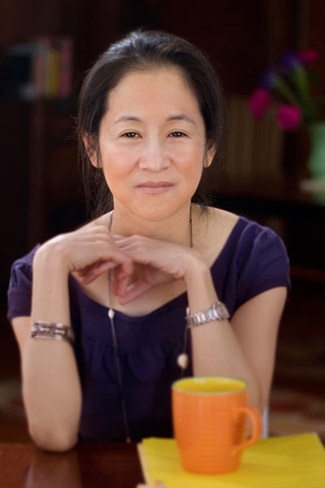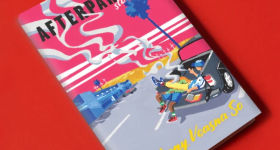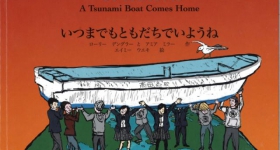In
the first few decades of the 20th century, an estimated 30,000
Japanese women arrived in the United States as “picture brides.” These were women,
young and often with few prospects back home, who had agreed to marry men they
only knew from photographs. The pictures often lied -- the men in the photographs
were much younger than the husbands they would meet, the bankers and hoteliers
in the photos would turn out to be farmers and lumber workers. In her latest
novel The Buddha in the Attic (which
was nominated for the National Book Award), Julie Otsuka narrates the story of
these women’s lives.
The
early history of the Japanese in America is familiar terrain for Otsuka, whose first
novel, When the Emperor Was Divine, narrated
the lives of a Japanese American family interned during World War II. The Buddha in the Attic serves as a kind
of historical prologue, spanning the decades preceding 1942 and the evacuation
order that would eventually displace Japanese Americans from their homes and
businesses. In eight chapters, the novel swiftly traces a chronology of these
women’s lives, from one displacement to another -- their arrival in the US
from Japan, and their move to the internment camps from their American homes. But the novel offers more than a historical
exercise; The Buddha in the Attic displays
Otsuka’s full-range of literary skill -- her prose is both spare and detailed,
and the narrative itself is an interesting experiment in perspective. For
narrative voice, Otsuka employs the first person plural “we,” and the effect is
powerful. An opening sequence reads, “On the boat the first thing we did -- before
deciding who we liked and didn’t like, before telling each other which one of
the islands we were from, and why we were leaving, before even bothering to
learn each other’s names -- was compare photographs of our husbands.”
The
novel continues in this way, each
sentence echoing the previous, building a subtle rhythm: “Some of us on the
boat were from Kyoto,” “Some of us were from Nara”; “On the boat we sometimes
lay awake,” “On the boat we complained about everything.” A collective
conscious of these women, whose lives are radically altered as they settle in
the xenophobic landscape of early 20th century America, slowly
emerges. Like the disappointment that greets them when they realized the men they
had married bore “no resemblance to the young men in the photographs,” so too
does the picturesque image of America fail them: “This is America, we would say to ourselves, there is no need to worry. And we would be wrong.”

Photo of the author by Robert Bessoir
Despite
using a collective first person speaker, Otsuka, to her credit, avoids
transforming the history into a univocal experience. The “we” who guides her reader takes
detours and follows the stories of individuals whose names eventually come into
focus. But over and again, even as the individual
details of their lives diverge, the women are united by their experience of
labor. In the fields, in their homes, at
the neighbors’ houses, as mothers and wives, they work -- their presence integral
in shaping the Pacific American landscape while simultaneously erased from it.
Their husbands urge them to “say nothing at all” as they “now belong to the
invisible world.” And for the Americans around them, the women’s presence is
both treasured and reviled. On one hand “[t]hey admired us for our strong backs
and nimble hands. Our stamina. Our discipline. Our docile dispositions. Our
unusual ability to tolerate the heat,” the narrator explains. On the other, the
women come to embody the nationalist fears of “Yellow Peril”: “They did not
want us as neighbors in their valleys. They did not want us as friends. […] We
were an unbeatable unstoppable economic machine and if our progress was not
checked the entire western United States would soon become the next Asiatic
outpost and colony.” This contradiction foreshadows the novel’s ending, which
stages the disappearances and the eventual internment of the Japanese following
the bombing of Pearl Harbor.
Soon
the narrator speaks of the executive order for evacuation, recounting the
disappearances and rumors swirling through the Japanese community. This comes to a head in the novel’s final
chapter, “A Disappearance,” in which the perspective shifts from the collective
voice of the Japanese women to a new collective, the town’s white residents: “The
Japanese have disappeared from our town. Their houses are boarded up and empty now.” The moment is jarring and
evocative; the voice that the reader had been accustomed to is suddenly disrupted,
the “we” has been othered into “them.”
More
than a reflection on America’s past, The
Buddha in the Attic is very much a novel about the present, offering a
subtle, historical allegory of our lived experience after 9/11. In an
interview, Otsuka herself said she saw parallels between the treatment of
the Japanese after the bombing of Pearl Harbor and the public scrutiny and
surveillance under which Muslim Americans (and their doppelgangers) struggled
in the past decade. At a few points, Otsuka cleverly weaves these moments into
the novel. In the novel’s closing
moments, a mayor reflects on the disappearances of the town’s Japanese
residents, citing the domestic costs of war: “There will be some things that
people see,” he says, “And there will be some things that people won’t see.
These things happen. And life goes on.”
If
the mayor’s circuitous language sounds familiar, it’s because the speech is pulled
directly from former Secretary of State Donald Rumsfeld. In fact, there are
other moments in the novel that echo the collective sense of national fear. Another
town citizen relates, “There was just so much about them we didn’t know […] It
made me uneasy. I always felt like there
was something they were trying to hide.” In capturing the paradox of American ethos -- a
land of immigrants, and a land of suspects -- The
Buddha in the Attic does far more than recover this valuable moment in
Japanese American history; it gestures towards a broader critique of the
national culture of the United States. Therein
lies its power.
Manan Desai recently completed his PhD at the University of Michigan, and currently serves on the board of directors for the South Asian American Digital Archive.









Comments